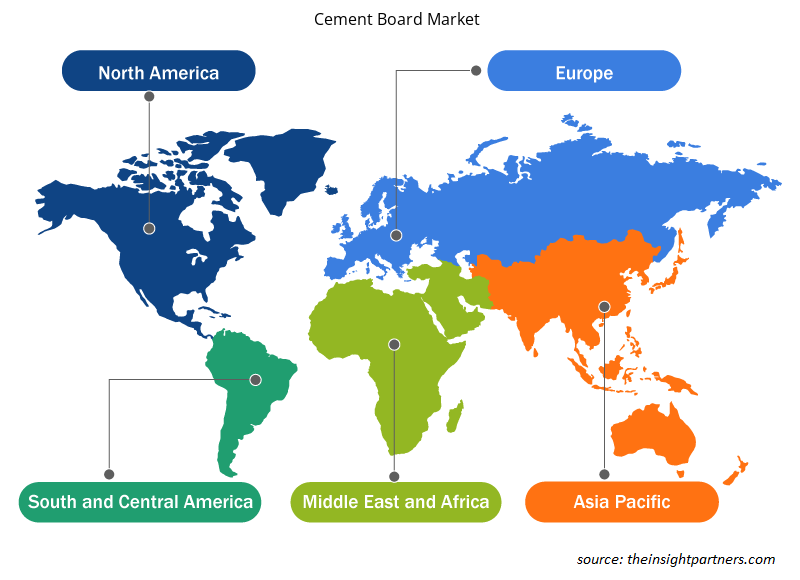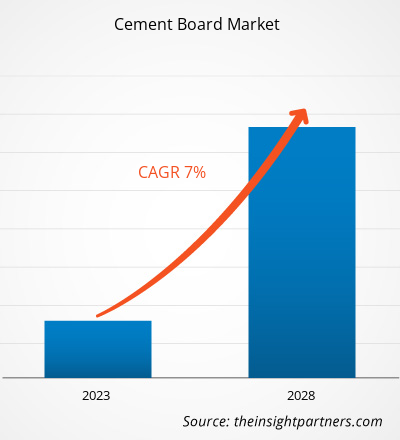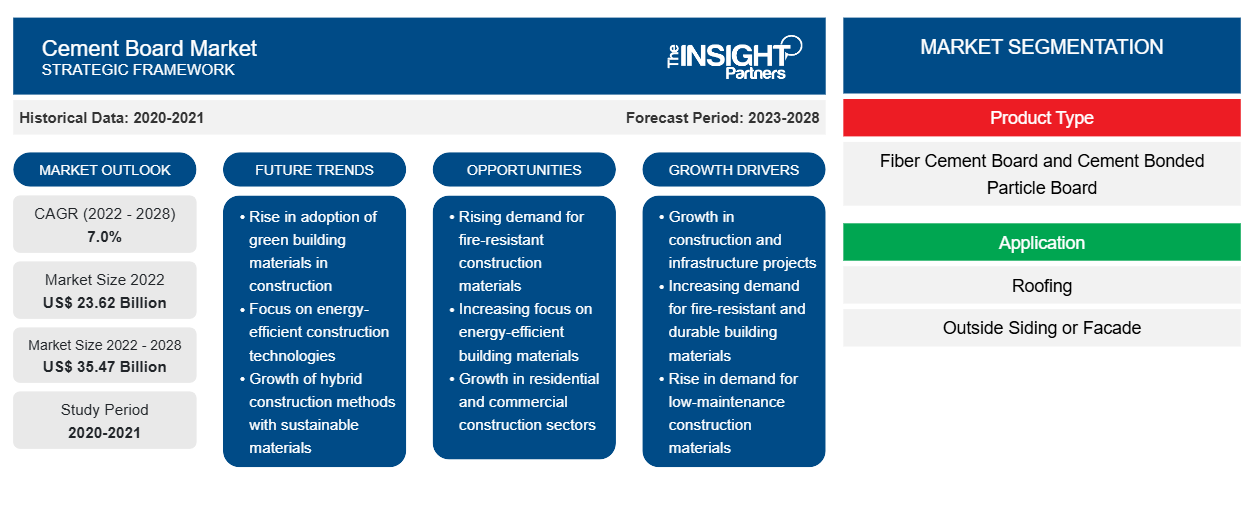[Rapporto di ricerca] Si prevede che il mercato dei pannelli in cemento crescerà da 23.616,63 milioni di dollari nel 2022 a 35.473,56 milioni di dollari entro il 2028; si stima che registrerà un CAGR del 7,0% dal 2022 al 2028.
ANALISI DI MERCATO
Il pannello di cemento è una combinazione di cemento, vetro, aggregati e rinforzi in fibra che vengono formati in fogli e utilizzati come pannelli di supporto per piastrelle e per costruire pareti o pavimenti. Il pannello di cemento comprende vari tipi di prodotti come pannelli di fibrocemento e pannelli di particelle legate al cemento. I pannelli di particelle legate al cemento hanno elevata rigidità, elevata resistenza al fuoco, elevata resistenza agli agenti atmosferici ed eccellenti proprietà di isolamento acustico. Sono ampiamente utilizzati in pavimenti, facciate, rivestimenti murali, cancelli e altri prodotti da costruzione. I pannelli di cemento sono utilizzati in varie attività di costruzione grazie alle loro eccellenti caratteristiche fisiche come non combustibile, resistenza all'acqua e ai raggi UV, resistenza alla decomposizione e all'avvolgimento e altro.
FATTORI DI CRESCITA E SFIDE
La crescente adozione di pannelli in cemento nel settore edile sta incrementando significativamente la crescita del mercato globale dei pannelli in cemento . La durevolezza è una delle qualità più desiderabili dei pannelli in cemento. I pannelli e i pannelli in cemento in genere durano più a lungo dei rivestimenti in vinile e di altri prodotti alternativi. Entro 10-15 anni, i rivestimenti in vinile possono mostrare segni di invecchiamento, mentre i pannelli in cemento possono durare fino a 30-50 anni o più. Inoltre, nella produzione di cemento, l'anidride carbonica è un sottoprodotto. Tuttavia, la produzione di rivestimenti in vinile contenenti cloruro di polivinile (PVC) produce più anidride carbonica rispetto alla produzione di cemento. Inoltre, i rivestimenti in vinile emettono gas per tutta la loro durata poiché occupano una discarica. Inoltre, l'aumento della domanda di edifici a risparmio energetico sta ulteriormente incrementando la crescita del mercato globale dei pannelli in cemento. La modernizzazione delle città nei paesi in via di sviluppo e l'aumento del reddito pro capite spingono l'uso di energia negli edifici in tutto il mondo. L'elevato consumo di energia negli edifici pubblici, residenziali e commerciali crea la necessità di risparmi energetici. Secondo l'Agenzia Internazionale per l'Energia, si prevede che gli edifici rappresenteranno circa il 41% del potenziale di risparmio energetico globale entro il 2035, mentre il settore industriale e quello dei trasporti ne deterranno rispettivamente il 24% e il 21%. Uno strato di pannelli di cemento viene applicato all'edificio per ridurre il trasferimento di calore attraverso le pareti, mantenendo l'interno più caldo in inverno e più fresco in estate, il che rende un edificio efficiente dal punto di vista energetico. Tuttavia, l'elevato costo associato all'acquisto e all'installazione di pannelli di cemento potrebbe limitarne la crescita di mercato.
Personalizza questo report in base alle tue esigenze
Riceverai la personalizzazione gratuita di qualsiasi report, comprese parti di questo report, o analisi a livello nazionale, pacchetto dati Excel, oltre a usufruire di grandi offerte e sconti per start-up e università
-
Scopri le principali tendenze di mercato in questo rapporto.Questo campione GRATUITO includerà analisi di dati che spaziano dalle tendenze di mercato alle stime e alle previsioni.
SEGMENTAZIONE E AMBITO DEL REPORT
"Global Cement Board Market Analysis to 2030" è uno studio specializzato e approfondito con un'attenzione particolare alle tendenze e alle opportunità di crescita del mercato globale dei pannelli in cemento. Il rapporto mira a fornire una panoramica del mercato globale dei pannelli in cemento con una segmentazione di mercato dettagliata per tipo di prodotto, applicazione, utilizzo finale e geografia. Il mercato globale dei pannelli in cemento ha assistito a una forte crescita nel recente passato e si prevede che continuerà questa tendenza durante il periodo di previsione. Il rapporto fornisce statistiche chiave sul consumo di pannelli in cemento in tutto il mondo insieme alla loro domanda nelle principali regioni e paesi. Inoltre, il rapporto fornisce la valutazione qualitativa di vari fattori che influenzano le prestazioni del mercato dei pannelli in cemento nelle principali regioni e paesi. Il rapporto include anche un'analisi completa dei principali attori del mercato dei pannelli in cemento e dei loro principali sviluppi strategici. Sono incluse anche diverse analisi sulle dinamiche di mercato per aiutare a identificare i principali fattori trainanti, le tendenze di mercato e le redditizie opportunità di mercato dei pannelli in cemento che, a loro volta, aiuterebbero a identificare le principali sacche di entrate.
Inoltre, l'analisi dell'ecosistema e l'analisi delle cinque forze di Porter forniscono una visione a 360 gradi del mercato globale dei pannelli in cemento, aiutando a comprendere l'intera filiera e i vari fattori che influenzano la crescita del mercato.
ANALISI SEGMENTALE
Il mercato globale dei pannelli in cemento è segmentato in base al tipo di prodotto, all'applicazione e all'uso finale. In base al tipo di prodotto, il mercato dei pannelli in cemento è segmentato in pannelli in fibrocemento e pannelli in particelle legate con cemento. In base all'applicazione, il mercato è classificato come coperture, rivestimenti esterni o facciate e altri.
In base all'uso finale, il mercato è diviso in residenziale e non residenziale. In base al tipo di prodotto, il segmento dei pannelli in fibrocemento ha rappresentato una quota di mercato significativa dei pannelli in cemento, che può essere attribuita alla crescente adozione di pannelli in cemento nel settore edile. I pannelli in fibrocemento sono un materiale da costruzione versatile e popolare grazie alla loro durevolezza e resistenza al fuoco, all'umidità e agli insetti. Composti da cemento, sabbia, fibre di cellulosa e acqua, questi pannelli sono comunemente utilizzati per rivestimenti, coperture, pavimenti e pareti interne in progetti di costruzione residenziali e commerciali. I pannelli in fibrocemento sono leggeri e facili da lavorare. Pertanto, sono preferiti da costruttori e appaltatori. In base all'applicazione, i rivestimenti esterni o le facciate hanno rappresentato un mercato importante. I rivestimenti o le facciate in fibrocemento possono essere utilizzati come alternativa al metallo, al legno tradizionale e al rivestimento o alla facciata in vinile. Il rivestimento o la facciata sono disponibili in varie texture, colori, dimensioni e forme, consentendo ad architetti e costruttori di creare design unici e visivamente accattivanti. Offre vantaggi chiave come durevolezza e resistenza agli agenti atmosferici, marciume, muffa e parassiti. In base all'uso finale, il segmento residenziale ha rappresentato una quota significativa nel mercato globale dei pannelli in cemento. La domanda di edilizia residenziale sta aumentando a causa della popolazione in aumento. I pannelli in fibrocemento e i pannelli in particelle di cemento sono ampiamente utilizzati nell'edilizia residenziale grazie ai loro vantaggi chiave, tra cui resistenza all'acqua e prevenzione delle termiti. Inoltre, la rapida urbanizzazione con una popolazione di espatriati in aumento e la crescente domanda di case ecologiche con un'impronta di carbonio inferiore aumenterebbero la crescita del mercato globale dei pannelli in cemento per il segmento residenziale durante il periodo di previsione. Ciò attirerà ulteriormente nuove opportunità di crescita per la crescita complessiva del settore.
ANALISI REGIONALE
Il rapporto fornisce una panoramica dettagliata del mercato globale dei pannelli in cemento rispetto a cinque regioni principali, vale a dire; Nord America, Europa, Asia-Pacifico (APAC), Medio Oriente e Africa (MEA) e Sud e Centro America. Medio Oriente e Africa hanno rappresentato una quota significativa del mercato e hanno raggiunto un valore di oltre 2 miliardi di dollari USA nel 2022 e si stima che raggiungeranno circa 3 miliardi di dollari USA nel 2030. Il rapido aumento delle attività di costruzione, in particolare in Medio Oriente, ha contribuito positivamente alla crescita del mercato in Medio Oriente e Africa. Si prevede inoltre che l'Asia Pacifica assisterà a una crescita considerevole del valore di oltre 8 miliardi di dollari USA nel 2022, attribuita alla crescente domanda di edifici a risparmio energetico nella regione che sta guidando la crescita del mercato globale dei pannelli in cemento. Si prevede inoltre che il Nord America assisterà a una crescita considerevole del valore di oltre 4 miliardi di dollari USA nel 2022, attribuita alla crescente preferenza dei pannelli in fibrocemento rispetto ai pannelli in legno che dovrebbe aumentare la crescita del mercato globale dei pannelli in cemento.
SVILUPPI DEL SETTORE E OPPORTUNITÀ FUTURE
Partnership, acquisizioni e lancio di nuovi prodotti sono risultate le principali strategie adottate dai player operanti nel mercato globale dei pannelli in cemento.
- Nel gennaio 2023, James Hardie Building Products ha annunciato una nuova partnership di distribuzione con Boise Cascade Company.
- Nel gennaio 2020, James Hardie Building Products ha presentato il suo pannello cementizio HardieBacker con tecnologia HydroDefense all'International Surface Event (TISE) di Las Vegas.
Approfondimenti regionali sul mercato dei pannelli in cemento
Le tendenze regionali e i fattori che influenzano il Cement Board Market durante il periodo di previsione sono stati ampiamente spiegati dagli analisti di Insight Partners. Questa sezione discute anche i segmenti e la geografia del Cement Board Market in Nord America, Europa, Asia Pacifico, Medio Oriente e Africa e Sud e Centro America.

- Ottieni i dati specifici regionali per il mercato dei pannelli in cemento
Ambito del rapporto sul mercato dei pannelli in cemento
| Attributo del report | Dettagli |
|---|---|
| Dimensioni del mercato nel 2022 | 23,62 miliardi di dollari USA |
| Dimensioni del mercato entro il 2028 | 35,47 miliardi di dollari USA |
| CAGR globale (2022 - 2028) | 7,0% |
| Dati storici | 2020-2021 |
| Periodo di previsione | 2023-2028 |
| Segmenti coperti |
Per tipo di prodotto
|
| Regioni e Paesi coperti |
America del Nord
|
| Leader di mercato e profili aziendali chiave |
|
Densità dei player del mercato del cemento: comprendere il suo impatto sulle dinamiche aziendali
Il mercato del Cement Board Market sta crescendo rapidamente, spinto dalla crescente domanda degli utenti finali dovuta a fattori quali l'evoluzione delle preferenze dei consumatori, i progressi tecnologici e una maggiore consapevolezza dei vantaggi del prodotto. Con l'aumento della domanda, le aziende stanno ampliando le loro offerte, innovando per soddisfare le esigenze dei consumatori e capitalizzando sulle tendenze emergenti, il che alimenta ulteriormente la crescita del mercato.
La densità degli operatori di mercato si riferisce alla distribuzione di aziende o società che operano in un particolare mercato o settore. Indica quanti concorrenti (operatori di mercato) sono presenti in un dato spazio di mercato in relazione alle sue dimensioni o al valore di mercato totale.
Le principali aziende che operano nel mercato dei pannelli in cemento sono:
- James Hardie Industries plc
- Plycem USA LLC
- Società per azioni Everest Industries Ltd.
- Gruppo Swisspearl SA
- Visaka Industries Ltd
Disclaimer : le aziende elencate sopra non sono classificate secondo un ordine particolare.

- Ottieni una panoramica dei principali attori del mercato del cemento
IMPATTO DEL COVID/IMPATTO DELLO SCENARIO GEOPOLITICO/IMPATTO DELLA RECESSIONE
La pandemia di COVID-19 ha portato a un declino nei progressi di molti settori in tutto il mondo. La chiusura degli impianti di produzione e le restrizioni commerciali in tutto il mondo hanno portato a vincoli nella catena di fornitura per i produttori in tutto il mondo. La pandemia di COVID-19 ha influenzato negativamente la crescita del settore chimico e dei materiali e del mercato dei pannelli di cemento. L'implementazione di misure per combattere la diffusione del SARS-CoV-2 ha avuto un impatto negativo sulla crescita di vari settori. Settori come imballaggio, beni di consumo, automotive e trasporti, tessile ed edilizia e costruzioni sono stati influenzati negativamente dalle improvvise interruzioni nell'efficienza operativa e nelle catene del valore dovute alla chiusura improvvisa dei confini nazionali e internazionali. Durante la pandemia di COVID-19, il calo dei ricavi e le crescenti sfide nella consegna dei progetti hanno portato alla contrazione del settore nella maggior parte dei mercati, con un corrispondente impatto negativo sulla forza lavoro. I costruttori hanno riscontrato ritardi e costi maggiori per le materie prime importate e i materiali da costruzione fuori sede a causa della chiusura di molte fabbriche per lunghi periodi. I danni al settore dell'edilizia e delle costruzioni hanno ostacolato la domanda di pannelli di cemento. Pertanto, il mercato dei pannelli in cemento si è ripreso piuttosto bene dalle conseguenze della pandemia e si prevede che crescerà nei prossimi anni.
PANORAMA COMPETITIVO E AZIENDE CHIAVE
Tra i principali attori che operano nel mercato dei pannelli di cemento figurano, tra gli altri, James Hardie Industries plc, Plycem USA LLC, Everest Industries Ltd, Swisspearl Group AG, Visaka Industries Ltd, Nichiha Corp, Soben International Ltd, SCG Building Materials Co., Ltd, Etex NV e Compagnie de Saint Gobain SA.
- Analisi storica (2 anni), anno base, previsione (7 anni) con CAGR
- Analisi PEST e SWOT
- Valore/volume delle dimensioni del mercato - Globale, Regionale, Nazionale
- Industria e panorama competitivo
- Set di dati Excel
Report recenti
Testimonianze
Motivo dell'acquisto
- Processo decisionale informato
- Comprensione delle dinamiche di mercato
- Analisi competitiva
- Analisi dei clienti
- Previsioni di mercato
- Mitigazione del rischio
- Pianificazione strategica
- Giustificazione degli investimenti
- Identificazione dei mercati emergenti
- Miglioramento delle strategie di marketing
- Aumento dell'efficienza operativa
- Allineamento alle tendenze normative























 Ottieni un campione gratuito per - Mercato dei pannelli di cemento
Ottieni un campione gratuito per - Mercato dei pannelli di cemento